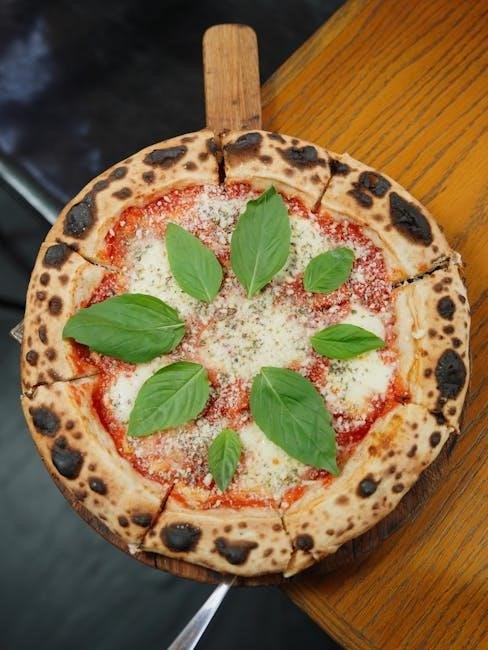Choosing the right round dining table size ensures comfort and style. This guide helps determine ideal dimensions‚ seating capacity‚ and space requirements for your dining area needs.

Standard Sizes for Round Dining Tables
Round dining tables typically range from 30 to 84 inches in diameter‚ accommodating various seating needs. A 42-inch table seats four‚ while larger sizes offer more space and versatility.
Small Round Dining Tables (30-44 inches diameter)
Small round dining tables‚ measuring 30-44 inches in diameter‚ are ideal for compact spaces and intimate gatherings. A 30-36 inch table comfortably seats 2-3 people‚ while a 42-inch table can accommodate 4. These tables are perfect for small apartments‚ breakfast nooks‚ or cozy kitchens. Their compact size saves space and allows for easy movement. Despite their smaller footprint‚ they offer a stylish and functional solution for everyday dining or casual meals‚ making them a versatile choice for modern living.
Medium Round Dining Tables (45-59 inches diameter)
Medium round dining tables‚ ranging from 45 to 59 inches in diameter‚ offer a balanced solution for small to medium-sized gatherings. A 45-inch table can comfortably seat 4-5 people‚ while a 54-inch table accommodates 6. These tables are versatile‚ fitting well in both compact and larger dining areas. Their moderate size ensures ample space for everyone without overwhelming the room. Ideal for everyday use‚ they blend practicality and style‚ making them a popular choice for modern homes seeking functionality and aesthetic appeal in their dining spaces.
Large Round Dining Tables (60 inches diameter and above)
Large round dining tables‚ measuring 60 inches or more in diameter‚ are ideal for spacious rooms and bigger families or gatherings. A 60-inch table can comfortably seat 6-8 people‚ while larger sizes‚ such as 72 inches‚ accommodate 8-10 guests. These tables create a grand focal point in any dining area‚ offering ample space for serving dishes and decor. Perfect for formal events or everyday meals‚ they combine elegance with functionality‚ ensuring everyone has enough room to dine comfortably without feeling crowded.

Seating Capacity for Round Dining Tables
Seating capacity depends on table size and personal comfort. A 60-inch table typically seats 6-8 people‚ while larger tables accommodate more guests comfortably.
Number of People Each Size Can Comfortably Seat
A round dining table’s seating capacity varies by size. Small tables (30-44 inches) seat 2-4 people‚ while medium tables (45-59 inches) accommodate 4-6. Larger tables (60 inches+) can seat 6-8 or more‚ depending on chair size and comfort preferences. A 60-inch table typically seats 6-8 comfortably‚ ensuring 24 inches of space per person. This guide helps you choose the right size for your needs‚ ensuring everyone has enough room to dine comfortably without feeling crowded.
Space Requirements per Person
Ensuring adequate space per person is crucial for comfort. Allocate 24-26 inches per person around the table‚ including elbow room and chair width. This guideline helps calculate the ideal table diameter. For example‚ a table seating six should have a diameter of at least 53 inches (24 x 6 = 144 inches‚ divided by π ≈ 45.8 inches). Adding 12 inches for chairs and movement‚ the minimum diameter becomes around 60 inches. Proper spacing ensures a comfortable dining experience without overcrowding.
Impact of Table Legs on Seating Capacity

Table legs significantly influence seating capacity. Bulky or wide legs can obstruct chair placement‚ reducing the number of people who can sit comfortably. Slim or tapered legs allow for more efficient use of space‚ maximizing seating potential. The design and placement of legs affect how chairs can be arranged without obstruction. Consider leg style and placement when determining the optimal seating arrangement for your round dining table to ensure smooth traffic flow and comfort for all diners.
Space Requirements for Round Dining Tables
Space requirements depend on the table’s diameter and room size. Ensure adequate clearance around the table for comfortable seating and easy movement‚ optimizing your dining area’s functionality and accessibility.
Minimum Diameter Based on Room Size
To determine the minimum diameter of a round dining table based on room size‚ consider the space needed for seating and movement. A table’s diameter should allow at least 22-24 inches per person for comfort. For small rooms‚ a 42-48 inch table is ideal‚ while larger spaces can accommodate 60 inches or more. Ensure the table fits without obstructing traffic flow‚ leaving 36 inches of clearance around it for easy movement.
Clearance Needed Around the Table
Proper clearance around a round dining table ensures comfortable movement and seating. Allow at least 36 inches of space between the table edge and walls or furniture to avoid obstruction. In smaller rooms‚ 30 inches can suffice‚ but 36 inches is ideal for ease of movement. For extendable tables or larger gatherings‚ additional clearance may be needed to accommodate extra leaves or seating arrangements. Adequate space enhances both functionality and dining experience.
How to Measure Your Dining Space
Accurately measure your dining area’s length and width to determine the best fit for your round table. Consider traffic flow and door placements for optimal spacing.
Measuring Length and Width of the Room
To measure your dining space‚ start by recording the room’s length and width using a tape measure. Measure along the longest and shortest points‚ ensuring accuracy. Note the placement of doors‚ windows‚ and any obstructions‚ as these affect table placement and movement.

Use these measurements to determine the maximum table size that fits comfortably‚ allowing at least 36 inches of clearance around the table for chairs and easy movement. This ensures a functional and inviting dining area.
Considering Traffic Flow in the Room
When measuring your dining space‚ consider the room’s traffic flow to ensure smooth movement around the table. Avoid placing the table in pathways or near doorways‚ as this can create bottlenecks. Ensure there is enough clearance between the table and walls or other furniture for easy navigation.
Aim for at least 36-42 inches of clearance around the table to allow comfortable passage. This ensures guests can move freely without feeling cramped‚ making the dining area functional and enjoyable for everyday use or special gatherings.
Materials and Durability Considerations
Materials like wood‚ metal‚ and glass offer durability and style. Choose based on your lifestyle and décor for a long-lasting‚ elegant dining solution.
Common Materials Used for Round Dining Tables
Round dining tables are crafted from various materials‚ each offering unique aesthetic and durability benefits. Wood‚ such as oak or walnut‚ provides warmth and timeless appeal‚ while metal or glass tables offer modern sleekness. Stone or marble tops add luxury and sophistication. Synthetic materials like recycled plastic or polywood are durable and low-maintenance‚ ideal for outdoor settings. The choice of material impacts both style and functionality‚ ensuring the table fits your lifestyle and décor seamlessly.
- Wood: Timeless and warm
- Metal: Modern and sleek
- Stone/Marble: Luxurious and durable
- Glass: Elegant and contemporary
- Recycled/Synthetic: Durable and eco-friendly
Pros and Cons of Different Materials
Different materials for round dining tables offer unique advantages and drawbacks. Wood provides a classic look but requires maintenance to prevent warping. Metal is durable and modern but can be noisy and cold. Glass offers elegance but is fragile and prone to fingerprints. Stone or marble is luxurious and sturdy but heavy and expensive. Synthetic materials‚ like polywood‚ are weather-resistant and low-maintenance but may lack the premium feel of natural options. Each material balances aesthetics‚ durability‚ and practicality.

- Wood: Classic but needs upkeep
- Metal: Durable yet cold
- Glass: Sleek but fragile
- Stone: Luxurious but heavy
- Synthetic: Low-maintenance but less premium

Extendable Round Dining Tables
Extendable round dining tables offer flexibility‚ accommodating varying guest numbers. They feature leaves or mechanisms to expand‚ converting from round to oval shapes effortlessly for larger gatherings.
- Ideal for versatile spaces
- Leaves or extension mechanisms
- Blends functionality with style
How Extendable Tables Work
Extendable round dining tables feature mechanisms like leaves or sliding parts to increase size. A leaf insertion system allows adding sections to the tabletop‚ expanding its diameter. For example‚ a 48-inch round table can become oval with an 18-inch leaf‚ seating up to six people. Some tables use a butterfly or hidden leaf design for seamless extension. This functionality enables the table to adapt to different gathering sizes while maintaining a round shape when closed‚ ensuring versatility and practicality for various dining needs.
- Leaf insertion systems
- Sliding or butterfly mechanisms
- Converts to oval shape when extended
Leaf Insertion and Size Adjustment
Leaf insertion allows round dining tables to expand by adding removable sections. A standard 18-inch leaf can extend a 48-inch table to 66 inches‚ converting it from round to oval. This feature enables seating for 4-6 people when closed and up to 8 when extended. Tables may use butterfly or hidden leaf mechanisms for smooth size adjustment. Ensure leaves are stored properly and fit securely to maintain table stability and even surface alignment‚ preserving both functionality and aesthetic appeal.
- Leaf sizes typically range from 12-24 inches
- Converts round tables to oval shape
- Accommodates additional seating needs

Legs and Base Design
Table legs and base design impact both aesthetics and functionality. Skinny legs offer a modern look‚ while thicker bases enhance stability‚ affecting seating capacity and visual balance.
Types of Legs and Their Aesthetic Impact
Round dining tables feature various leg styles‚ each offering unique aesthetic appeal. Tapered legs create a sleek‚ modern look‚ while thicker‚ ornate legs add a traditional or rustic vibe. Pedestal-style bases provide a sturdy‚ minimalist appearance‚ ideal for larger tables‚ and can enhance a room’s grandeur. The leg design should complement the table’s size and the room’s decor‚ ensuring a balanced and harmonious visual effect that aligns with your desired dining space ambiance.
Impact of Base Design on Table Stability
The base design significantly affects a round dining table’s stability. Wider bases or multiple legs provide better weight distribution‚ reducing wobble. A sturdy‚ heavy base enhances durability‚ while narrow or single-leg designs may compromise stability. Material thickness and construction quality also play a role‚ with thicker bases offering greater support. Ensuring the base aligns with the table’s size and weight ensures long-term stability and prevents tipping‚ especially on uneven surfaces or with heavy use.
Height of Round Dining Tables
Standard round dining tables typically range in height from 28 to 30 inches‚ ensuring comfortable seating and alignment with chair heights for an ergonomic dining experience.
Standard Table Height Range
The standard height for round dining tables typically ranges from 28 to 30 inches‚ ensuring comfortable seating and ergonomic alignment with chair dimensions. This height allows diners to sit with their elbows at a 90-degree angle‚ promoting relaxed conversations and ease of movement. Proper table height is essential for creating a welcoming and functional dining environment‚ as it directly impacts posture and overall comfort during meals. Always consider chair height when selecting a table to maintain harmony and usability in your dining space.
Importance of Table Height for Comfort
Table height plays a crucial role in ensuring a comfortable dining experience. A height of 28-30 inches is ideal‚ as it aligns with standard chair dimensions and promotes proper posture. This range allows diners to sit with their elbows at a 90-degree angle‚ reducing strain on the neck and shoulders. Incorrect table height can lead to discomfort‚ making meals less enjoyable. Ergonomic alignment is key to creating a welcoming and functional dining environment that prioritizes both style and comfort for everyone seated;
Shape Variations and Aesthetics
Round dining tables offer versatility in design‚ with options like smooth edges‚ scalloped details‚ or live-edge styles. These variations enhance aesthetic appeal and complement diverse home décors‚ creating inviting spaces that reflect personal style while maintaining functionality.
Different Edge Styles and Shapes
Round dining tables come in various edge styles‚ including smooth‚ scalloped‚ beveled‚ or live-edge designs. These styles add unique aesthetic touches‚ from modern minimalism to rustic charm. While traditional round tables feature a classic‚ uniform curve‚ scalloped edges create a softer‚ wavy appearance. Beveled edges offer a sleek‚ angular contrast‚ enhancing contemporary decors. Live-edge designs incorporate natural wood imperfections‚ adding organic beauty. Each style complements different interiors‚ allowing homeowners to choose a table that aligns with their personal taste and decor preferences.
Matching the Table Style to Your Décor
Matching your round dining table style to your décor ensures a cohesive and inviting space. Consider materials like natural oak for a rustic vibe or sleek black finishes for modern aesthetics. Minimalist designs blend seamlessly with contemporary interiors‚ while ornate details complement traditional settings. For coastal themes‚ whitewashed or distressed finishes are ideal. Industrial styles with metal bases suit urban decors‚ and reclaimed wood adds warmth to country-inspired rooms. Selecting a table that aligns with your décor enhances harmony and beauty in your dining area‚ creating a welcoming atmosphere for family and guests.

Budget Considerations

Round dining tables vary in price based on size‚ material‚ and features. Set a budget and balance size‚ material quality‚ and additional features to find the best value.
Price Range for Round Dining Tables
Round dining tables vary in price‚ with small‚ basic models starting around $100-$300. Mid-range tables with quality materials like wood or metal typically cost $400-$800. Larger or designer tables can range from $1‚000 to $3‚000 or more. Factors like size‚ material‚ and additional features (e.g.‚ extension leaves) significantly impact the price. Budget-friendly options are available‚ but luxury materials or custom designs increase costs. Consider your needs and budget to find a table that balances size‚ material‚ and affordability.
How to Balance Size‚ Material‚ and Cost
To balance size‚ material‚ and cost‚ assess your needs and prioritize. Measure your space to determine the ideal table size‚ then choose materials that fit your budget. Consider traffic flow and seating requirements. Durable materials like solid wood or metal may cost more but offer longevity‚ while budget-friendly options like veneer or plastic are more affordable. Allocate your budget accordingly‚ focusing on what matters most—size for functionality‚ material for durability‚ or cost for affordability. This ensures a practical and stylish choice.
Selecting the right round dining table involves balancing size‚ material‚ and cost. By understanding standard sizes‚ seating capacities‚ and space requirements‚ you can make an informed decision; Consider your lifestyle‚ budget‚ and room dimensions to choose a table that enhances comfort and aesthetics. Whether for small gatherings or large events‚ the perfect round dining table will complement your home decor and meet your needs effectively‚ ensuring a harmonious and functional dining experience for years to come.
